Chang Yi (張毅), creative director of glass art workshop Liuligongfang (琉璃工房), isn’t a populist.
“The problem is that the more you educate yourself, the farther away you will be from the audience,” said Chang, who in 1986 abruptly left his career as a film director to focus instead on glass art.
True to its founder, Liuligongfang has just launched a major art exhibition that is uninterested in courting a mainstream audience. No subject is contemporary; everything is spiritual.
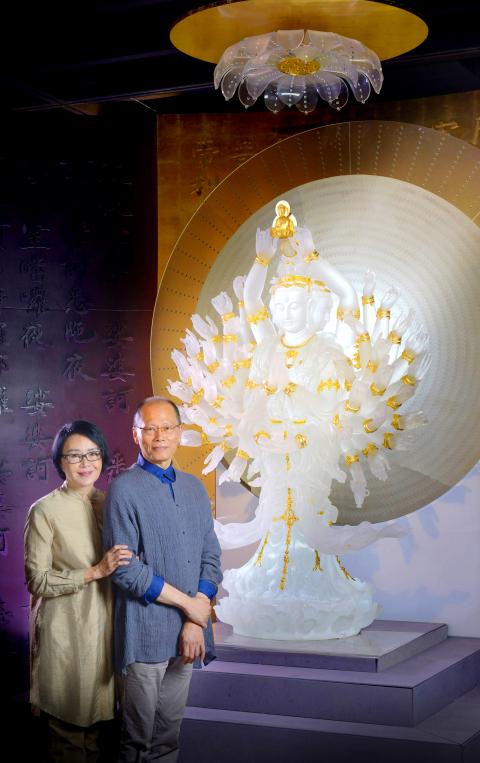
Photo courtesy of liuligongfang
Only With Compassion (唯有慈悲) is divided into two parts, both tied to the Buddhist faith. One section takes flowers as its theme, a symbol of purity and life.
The other is based purely on Buddha. Created mostly by Yang Hui-shan (楊惠珊), they are serene sculptures with a melancholy undercurrent.
Formless, But Not Without Form (無相無無相, 1998) is a series of clear, ice-like blocks. Trapped inside are sculptures of Buddha, frozen and preserved in time like a woolly mammoth.
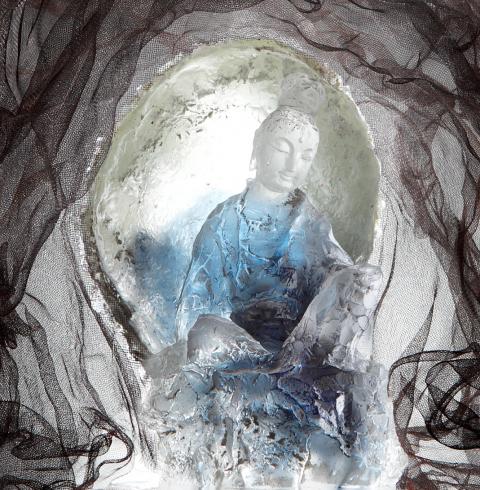
Photo courtesy of liuligongfang
The Enlightenment (更見菩提) series was completed in 2010. They are intricately conceived figures: glass Buddhas fused to billowing wings of stainless steel, which behave as a metaphor for human misery.
Young people are always striving to avoid suffering, but suffering should be welcomed as a “significant part of life,” Chang said.
“Here, you can still see the Buddha through the steel, yet the Buddha form embraces and harmonizes with it.”
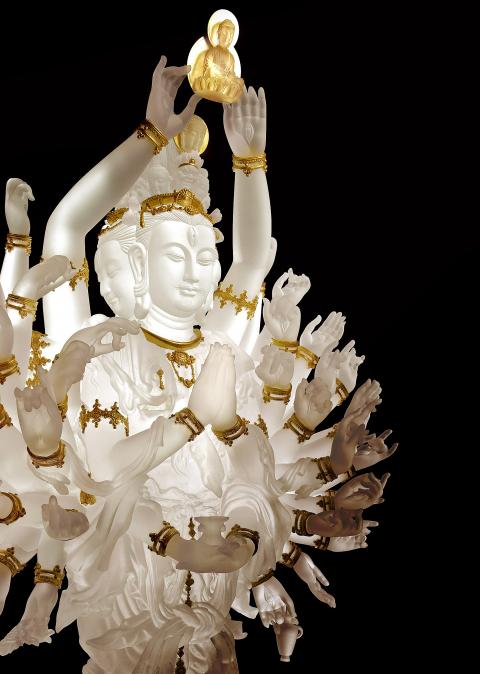
Photo courtesy of liuligongfang
TECHNIQUE
Like all Liuligongfang works, the glass Buddhas were created with an expensive and technically difficult pate-de-verre method, or “lost-wax casting.”
In this method, a mound of wax is carved in the shape of the desired sculpture. The artist encases the wax form with plastic and then steams out the wax to create an empty mold. This mold is packed with crushed glass paste — the pate — and heated in a kiln. After cooling, the glass sculpture is dusted off and sand-etched.
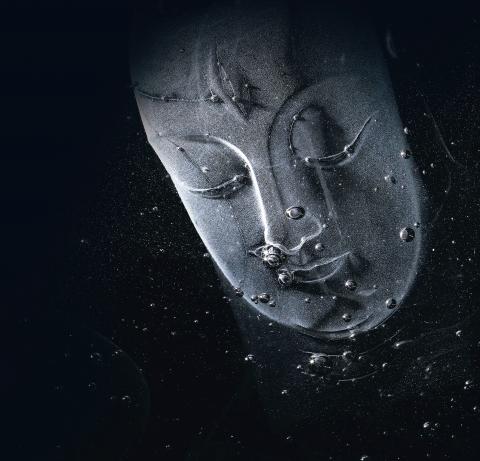
Photos courtesy of liuligongfang
If you are Chang, the process can be completed in a matter of months. His sketches are light and simple. He delegates tasks and doesn’t hover. “I just say, ‘do this, I will come back later,’” he said.
At the exhibition, Chang is showing his own series of Buddhist deities, which date to 2001. They are statuettes created by blending crushed glass of every color. The resulting shade is black. Edges are left unfinished, so that the Buddhas, a re-imagining of an abstract godly form, are shockingly imperfect, animated by an aggressive claim to reality.
Yang’s technical acumen is different. Her plans are grand and their realization is precisely controlled.
The exhibition houses three of her Guanyin (觀音) sculptures; each was subjected to a tireless scrutiny. At the show opening last week, Yang was still putting the finishing touches on her latest Guanyin, an elaborate glass sculpture with many pairs of arms, each pair delicately suspended in a gesture different from the rest.
Planning for the sculpture began four years ago; just the heating and cooling took one year and two months, Yang said. At two meters tall, it’s currently the world’s tallest glass Buddha.
In the flower gallery, Yang is showing Springtime Dance (春之舞), a large crystal flower with stamens tapering delicately into the shape of dancers. It is Yang’s breakout work — a limited edition that’s now part of the collection of the Corning Museum of Glass and Denmark’s Glasmuseet Ebeltof.
Yang is also showing a new series completed last year.
These flowers are topped with opaque, wax-like full blooms that have a visual richness like creme brulee. This latest collection is unique in that it uses a highly faithful version of pate-de-verre, Yang said. In its original form, pate-de-verre uses only a fine glass powder, which creates entirely opaque glass.
NEW DIRECTIONS
Over its 26 years, Liuligongfang has experimented with glass granules, which result in a shower of tiny bubbles, and with glass chunks, which melt and harden into material that is completely clear.
Chang and Yang have also experimented with heat, vitrifying opaque glass to something more transparent and crystallized.
These techniques, honed through trial and error, have become the Liuligongfang language, said Chang, adding that it is vocabulary best suited to “traditional Chinese” icons — most recently, to Buddha. Since 1996, the studio has been deepening its investment in faith-inspired projects.
For Chang, glass is a natural match for Buddha figures. “[Glass] is so transparent, so clear, so pure, which suggests meditation, becoming crystal clear,” he said.
Yang says Buddhist-inflected projects are what will emerge as the studio’s strongest appeal, as trends and cultural politics continue to shift in Taiwan.
“I talk about the spirit of Buddhism. It’s a very important core value for us. I think we need those kinds of emotions in this society — and in the world,” Yang said.
“When people feel anxiety, they need something that can release their suffering. If the works can patch [up] their hearts, they will accept them,” she said.
■ Halls 3 and 4 at Fo Guang Shan Buddha Memorial Center (高雄佛光山佛陀紀念館), 1 Tongling Rd, Greater Kaohsiung (高雄市統嶺路1號), tel: (07) 656-3033 X 4002. Open Mondays to Fridays from 9am to 7pm, and Saturday and Sunday from 9am to 8pm
■ Until April 6
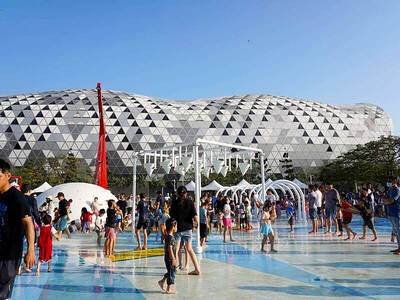
The Taipei Times last week reported that the rising share of seniors in the population is reshaping the nation’s housing markets. According to data from the Ministry of the Interior, about 850,000 residences were occupied by elderly people in the first quarter, including 655,000 that housed only one resident. H&B Realty chief researcher Jessica Hsu (徐佳馨), quoted in the article, said that there is rising demand for elderly-friendly housing, including units with elevators, barrier-free layouts and proximity to healthcare services. Hsu and others cited in the article highlighted the changing family residential dynamics, as children no longer live with parents,

The classic warmth of a good old-fashioned izakaya beckons you in, all cozy nooks and dark wood finishes, as tables order a third round and waiters sling tapas-sized bites and assorted — sometimes unidentifiable — skewered meats. But there’s a romantic hush about this Ximending (西門町) hotspot, with cocktails savored, plating elegant and never rushed and daters and diners lit by candlelight and chandelier. Each chair is mismatched and the assorted tables appear to be the fanciest picks from a nearby flea market. A naked sewing mannequin stands in a dimly lit corner, adorned with antique mirrors and draped foliage

The election of Cheng Li-wun (鄭麗文) as chair of the Chinese Nationalist Party (KMT) marked a triumphant return of pride in the “Chinese” in the party name. Cheng wants Taiwanese to be proud to call themselves Chinese again. The unambiguous winner was a return to the KMT ideology that formed in the early 2000s under then chairman Lien Chan (連戰) and president Ma Ying-jeou (馬英九) put into practice as far as he could, until ultimately thwarted by hundreds of thousands of protestors thronging the streets in what became known as the Sunflower movement in 2014. Cheng is an unambiguous Chinese ethnonationalist,

I was 10 when I read an article in the local paper about the Air Guitar World Championships, which take place every year in my home town of Oulu, Finland. My parents had helped out at the very first contest back in 1996 — my mum gave out fliers, my dad sorted the music. Since then, national championships have been held all across the world, with the winners assembling in Oulu every summer. At the time, I asked my parents if I could compete. At first they were hesitant; the event was in a bar, and there would be a lot